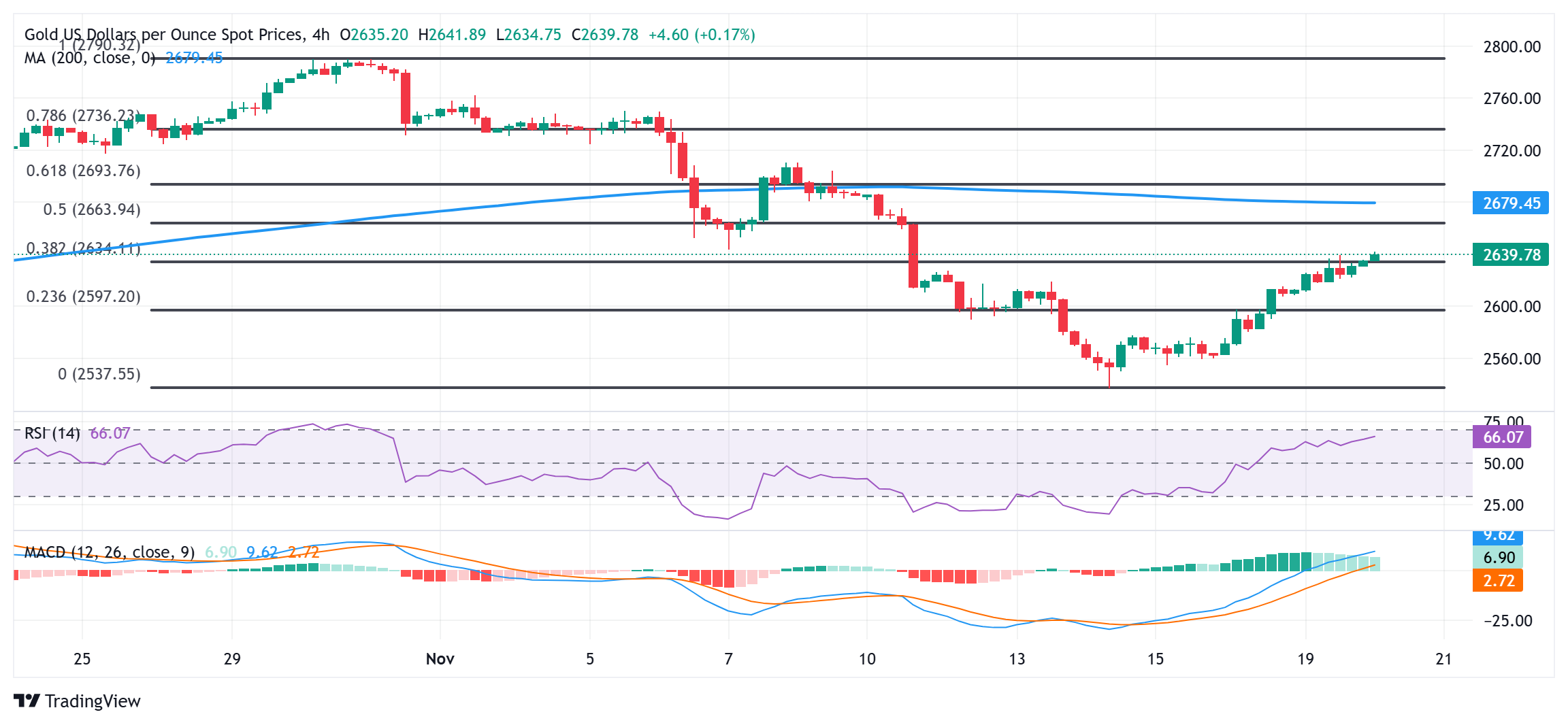Gold price advances to over one-week high on rising geopolitical risks


- Gold price scales higher for the third straight day as Russia-Ukraine tensions continue to drive haven flows.
- Rebounding US bond yields offer some support to the US Dollar and might cap further gains for the XAU/USD.
- Traders look to speeches from influential FOMC members for rate-cut cues.
Gold price (XAU/USD) attracts some follow-through buying for the third consecutive day on Wednesday and climbs to a one-and-half-week high, around the $2,641-2,642 region during the Asian session. Mounting Russia-Ukraine tensions continue to boost demand for traditional safe-haven assets, which, along with subdued US Dollar (USD) price action, act as a tailwind for the precious metal.
That said, the overnight comments from Russian and US officials helped ease market concerns about the onset of a full-blown nuclear war, which is evident from a generally positive tone around the equity markets. Apart from this, a goodish pickup in the US Treasury bond yields favors the USD bulls and warrants some caution before positioning for any further appreciating move for the Gold price.
Gold price continues to benefit from haven flows amid escalating geopolitical tensions
- Investors remain concerned about the risk of a further escalation of geopolitical tensions between Russia and Ukraine, which drives haven flows towards the Gold price for the third straight day.
- Russian President Vladimir Putin upped the ante on Tuesday and signed a decree approving its updated nuclear doctrine, which shifts the parameters on when Russia can use nuclear weapons.
- Ukraine acted on the go-ahead from the US to use American-made missiles for strikes within Russia and launched ATACMS missiles to attack a Russian military facility in the Bryansk border region.
- Russian Foreign Minister Sergei Lavrov said the country will do everything possible to avoid a nuclear war. The White House confirmed that the US does not plan to adjust its nuclear posture.
- Markets have been positioning for potential tariffs and tax cuts by the incoming Trump administration, which could lead to higher inflation and fewer interest rate cuts by the Federal Reserve.
- Kansas Fed President Jeffrey Schmid said on Tuesday that large fiscal deficits will not cause inflationary pressures because the central bank will prevent it, though that could mean higher interest rates.
- According to the CME Group's FedWatch Tool, traders are currently pricing in a less than 60% chance for a 25-basis-points rate cut by the Fed at the upcoming monetary policy meeting in December.
- The US Treasury bond yields resume their uptrend following the previous day's sharp slide and assist the US Dollar in stalling its pullback from the year-to-date peak, which might cap the XAU/USD.
- A slew of influential FOMC members are due to speak later today and influence expectations about the Fed's rate-cut path, providing some meaningful impetus to the non-yielding yellow metal.
Gold price could climb further toward $2,660; technical setup warrants caution for bulls
The recovery momentum from a two-month low touched last week lifts the Gold price beyond the 38.2% Fibonacci retracement level of the recent sharp retracement slide from the all-time peak, favoring bullish traders. Adding to this, bullish oscillators on hourly charts support prospects for a further intraday appreciating move towards the $2,658-2,660 region en route to the $2,670-2,672 congestion zone. Some follow-through buying could allow the XAU/USD to aim back towards reclaiming the $2,700 round figure.

On the flip side, the $2,622-2,620 area now seems to protect the immediate downside ahead of the $2,600 mark. A convincing break below the latter could make the Gold price vulnerable to accelerate the fall to the 100-day Simple Moving Average (SMA), around the $2,555 region, with some intermediate support near the $2,570 zone. This is followed by last week’s swing low, around the $2,537-2,536 area, which if broken decisively will be seen as a fresh trigger for bearish traders and set the stage for deeper losses.
Gold FAQs
Why do people invest in Gold?
Gold has played a key role in human’s history as it has been widely used as a store of value and medium of exchange. Currently, apart from its shine and usage for jewelry, the precious metal is widely seen as a safe-haven asset, meaning that it is considered a good investment during turbulent times. Gold is also widely seen as a hedge against inflation and against depreciating currencies as it doesn’t rely on any specific issuer or government.
Who buys the most Gold?
Central banks are the biggest Gold holders. In their aim to support their currencies in turbulent times, central banks tend to diversify their reserves and buy Gold to improve the perceived strength of the economy and the currency. High Gold reserves can be a source of trust for a country’s solvency. Central banks added 1,136 tonnes of Gold worth around $70 billion to their reserves in 2022, according to data from the World Gold Council. This is the highest yearly purchase since records began. Central banks from emerging economies such as China, India and Turkey are quickly increasing their Gold reserves.
How is Gold correlated with other assets?
Gold has an inverse correlation with the US Dollar and US Treasuries, which are both major reserve and safe-haven assets. When the Dollar depreciates, Gold tends to rise, enabling investors and central banks to diversify their assets in turbulent times. Gold is also inversely correlated with risk assets. A rally in the stock market tends to weaken Gold price, while sell-offs in riskier markets tend to favor the precious metal.
What does the price of Gold depend on?
The price can move due to a wide range of factors. Geopolitical instability or fears of a deep recession can quickly make Gold price escalate due to its safe-haven status. As a yield-less asset, Gold tends to rise with lower interest rates, while higher cost of money usually weighs down on the yellow metal. Still, most moves depend on how the US Dollar (USD) behaves as the asset is priced in dollars (XAU/USD). A strong Dollar tends to keep the price of Gold controlled, whereas a weaker Dollar is likely to push Gold prices up.


